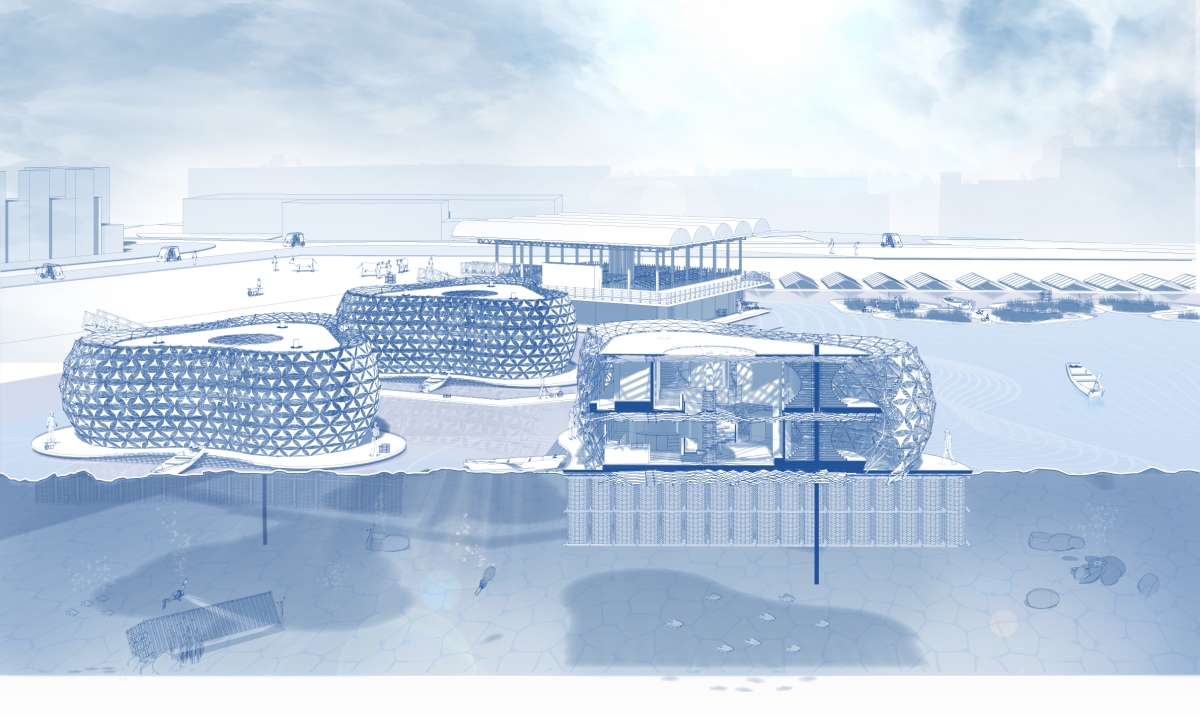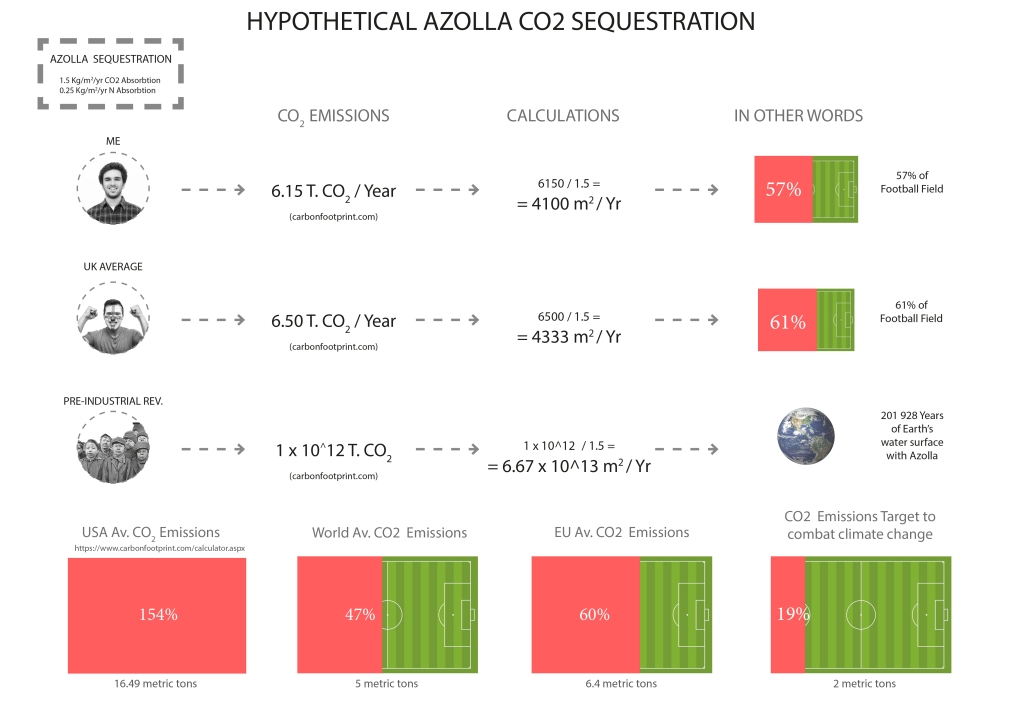WHAT IS AZOLLA?

Azolla is a minuscule floating plant that forms part of a genus of species of aquatic ferns, also known as Mosquito Fern. It holds the world record in biomass producer – doubling in 2-3 days. The secret behind this plant is its symbiotic relationship with nitrogen fixing cyanobacterium Anabaena making it a superorganism. The Azolla Provides a microclimate for the cyanobacteria in exchange for nitrate fertiliser. Azolla is the only known case where a symbiotic relationship endures during the fern’s reproductive cycle and is passed on to the next generation. They also have a complimentary photosynthesis, using light from most of the visible spectrum and their growth is accelerated with elevated CO2 and Nitrogen.




Azolla is capable of producing natural biofertiliser, bioplastics because of its sugar contents and biofuel because of the large amount of lipids. Its growth requirements can accommodate many climates too, allowing it to be classified as a weed in many countries. I was able to study the necessary m2 of growing Azolla to sequester the same amount as my yearly CO2 emissions, resulting in 57% of a football field equivalent of growing Azolla to make me carbon neutral.

Why is this useful? Climate change will inevitably bring more adverse climate conditions that will put many world wide crops at risk and, as a consequence, will affect our lives. A crop that produces biomass at the speed of Azolla provides at advantage in flexibility: a soya bean can take months to grow until ready to be harvested, Azolla can be harvested twice a week. This plant has the potential to be used in the larger agricultural sector and diminish the Greenhouse Gas Emissions of one of the most pollutant sectors.

.
REAL LIFE ACTION
I contacted the Azolla Research Group at the University of Utrecht and they kindly accepted to give us a tour of their research facilities, providing us with an in-depth insight into the aquatic fern. I also decided to approach the Floating Farm with a proposal of using Azolla in their dairy process. They agreed to explore this and I put them in contact with the research team in the University of Utrecht, who are now cooperating with the dairy farm’s team in decreasing the carbon emissions of the cows on the farm.

.
ARCHITECTURAL PROPOSAL

The Floating Azolla District consists on a proposed community that emphasises a circular economy with a focus on sustainable agriculture in Rotterdam. It builds on to the existing Floating Farm found in the M4H area. It is formed of three areas:
1) Azolla – Dwellings combining a series of residential units for the increasing number of young entrepreneurs in the RID with three central cores growing stacked trays of Azolla as in vertical farming.
2) The Floating Farm which continues to produce dairy products and a Bamboo growing area to maintain the upkeep of floating platforms and construction of new dwellings. Floating rice paddies are grown in the warmer months in a closely monitored system of permaculture.
3) A production facility which concentrates on research and development into Azolla as well as retrieving the water fern’s byproducts such as bioplastics extracted from the sugars; biofuel, from the lipids; and bamboo plywood lumber for the construction of the expanding Floating District.




Floating Azolla District – Dwellings

This section concentrates on the detail construction of the Azolla-Dwellings. These floating units are designed to be used as a combination of co-housing for entrepreneurs working in the Rotterdam Innovation District, where the Floating Farm is located, and indoor Azolla growing facilities which is then used further along in the masterplan. The growing areas are built on a series of building components that provide support for trays of Azolla to be grown in a vertical farming manner and provide support for the floor plates as well as anchoring for the entire dwelling.

The materials are a combination of local bamboo grown on a series of floating platforms that prevent the cold winter winds from affecting the overall masterplan and pallets sourced from neighbouring industrial facilities. Using the reciprocal building system developed in Brief 1, a series of stacked components are linked to form the vertical farming support for the Azolla. This system is then extended to support the floors for the dwellings.
Similar to an aperture ring on a camera, this mechanism uses the varying tide to automatically collect the Azolla from the vertical farming trays to then be used throughout the Masterplan. By displacing 2.5% of the area for each tray every tidal change, this mechanism collects 50% of the harvest every 10 days allowing for a continuous growth of Azolla.



The dwellings’ facade is a result of a careful analysis of harmful and beneficial solar radiation. By setting an initial average temperature to monitory, the facade will block sun that naturally would drive the temperature above the chosen one and the beneficial would bring the temperature up. This shading serves a buffer zone that surrounds the internal living spaces and is used to grow vegetables for the residents.

Semi-public spaces are located on the ground floor (open plan kitchen and living) and bedrooms are located on the first floor, surround a central spiral staircase for circulation.




The same building system based on reciprocal structures is coated in azolla bioplastic preventing the wood from rotting and making the form waterproof. These are used as underwater columns which allow the dwellings and platforms to float. Each ‘column’ can support a load of 2011Kg.

SITE LOCATION

Based on relationship between the University of Utrecht and the Floating Farm taking place outside the initially academic intention of the visit, I decided to use the Floating Farm as a site and a starting point for my proposal. The floating farm is intended to stand out and create an awareness of the possibility or idea of living on water and taking ownership of one’s food production, which seems to match the potential uses and benefits of Azolla. The researchers at the University of Utrecht expressed their need of getting the advantages of this plant to a wider public and this remained in my mind, possibly being the main reason behind my approach to the Floating Farm.
The Floating Farm sits in the Merwehaven area or M4H in the Port of Rotterdam. Highlighted below are the natural site conditions that determined the placement of the masterplan parts according to their function. Bamboo growing pods are placed southwards of the port to block the winter wind while allowing the summer winds from the west to navigate through.

In 2007, Rotterdam announced its ambition to become 100% climate-proof by 2025 despite having 80% of its land underwater, therefore it was important to look at the flood risk and tidal change. The Merwehaven area in Rotterdam seems to have an average tidal change of 2 metres which I thought could be taken advantage of in a mechanical system mentioned previously.


.
BUILDING SYSTEM & MATERIAL RESEARCH
The reciprocal building system used in the construction of the dwellings began by looking into the Fern plant and its’ form. All ferns are Pinnate – central axis and smaller side branches – considered a primitive condition. The veins never coalesce and are known to be ‘free’. The leaves that are broadly ovate or triangular tend to be born at right angles to the sunlight.

I then decided to model a leaf digitally, attempting to simulate the fractal nature found in a fern frond and the leaves to 3 degrees of fractals. I then simplified the fern frond to 2 levels to allow for easier laser cutting and structural stability. The large perimeter meant, therefore, there was a large amount of surface area for friction so I explored different configurations and tested their intersections.

I then selected the fern frond intersection I found to show the best stability out of the tested ones shown previously. By arraying them further, they began to curve. When pressure is applied to the top of the arch, the intersections are strengthened and the piece appears to gain structural integrity.

When a full revolution is completed, the components appear to gain their maximum structural integrity. Since I had decided to digitally model the fern frond, I was able to decrease the distance between the individual leaves in the centre of each frond through grasshopper. By doing this, the intersections connecting a frond with another were less tight in the centre than on the extremities of each frond, allowing for double curvature.

I continued to iterate the leave by decreasing any arching on the leaf and finding the minimum component, the smallest possible component in the system. By arraying a component formed of 3 ‘leaves’ on one hand and 2 on the other, I would be able to grow the system in one direction as before due to the reciprocal organisation and in the other direction by staggering the adjacent component. The stress tests of this arrangement showed a phased failure of the ‘column’. Instead of breaking at once, row by row of components failed with time, outwards-inwards.


I extracted the minimum possible component from the previous iterations and attempted to merge the system with firstly, 3d printed PLA bioplastic components and then with an algae bioplastic produced at home. I became interested in the idea of being able to coat the wood in an algae bioplastic substituting the need for any epoxy for waterproofing. The stress tests for this component showed a surprising total of 956 kg-force for it to fail.

Here, I began combining different quantities of vegetable glycerine, agar agar (extracted from red algae and used for cooking) and water. By changing the ratios of agar and glycerine I was able to create 2 different bioplastics: one being brittle and the other flexible. See above for the flexible sample and below for the brittle sample. Both samples appeared to fail under the same 7 Kg-force.
For additional information please visit:






























